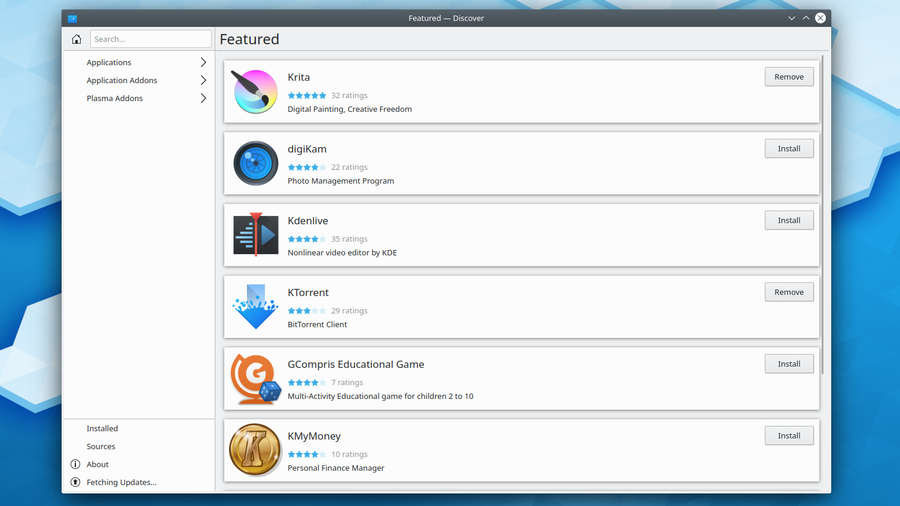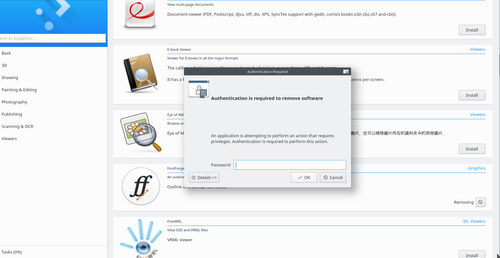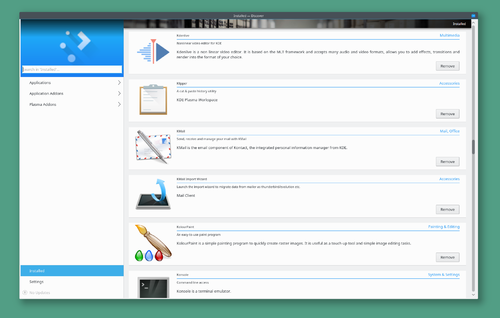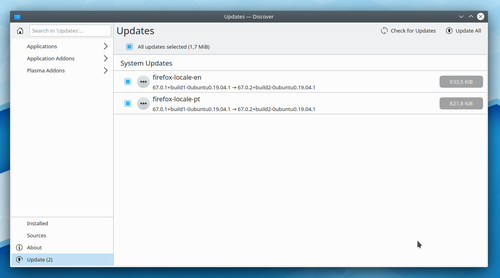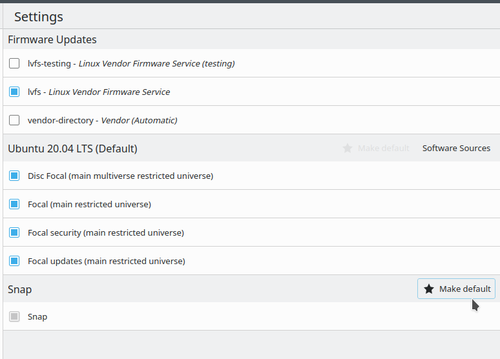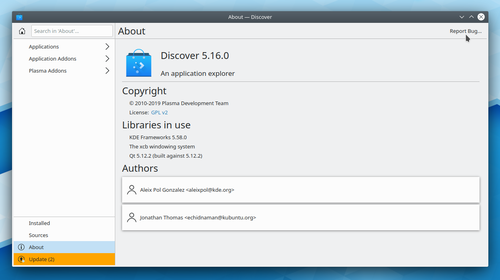Discover
Willkommen zu "Discover"
Die Programmverwaltung für das 22-zigste Jahrhundert
Discover bedeutet sowohl Programme als auch Erweiterungen aus einer Hand. Manchmal wird Discover im Deutschen auch als Entdecken bezeichnet. Es wurde von Grund auf entwickelt um den Nutzern eine einfache Handhabung zu bieten und sich gleichzeitig einfach in die verschiedenen Distributionen zu integrieren. Es soll ein Ort sein an dem fehlendes Expertenwissen niemanden davon abhält, das zu tun was er tun möchte - in diesem Fall die Installation von Programmen und Erweiterungen.
Discover wurde von Grund auf neu gestaltet um die Nutzererfahrung eindeutiger und intuitiver zu machen. Wir bauen mit unser Arbeit auf der neuen Kirigami-Technologie und auf neuen Programmauslieferungstechnologien auf, aber genauso auf dem sicheren Repository-System. Ziel ist es ein Programm für jede Distribution und jedes Erfahrungslevel zu bieten. Ein Programm, dass Freude macht es zu benutzen und es anderen zur Verfügung zu stellen.
Was ist "Discover"?
Discover ist gedacht für Nutzer und Distributionen für die das Terminal nicht die bevorzugte Methode zur Installation von Anwendungen und Erweiterungen ist. Es ist gedacht für Situationen in denen man ein intuitives und einfach zu benutzendes Werkzeug verwenden möchte, dass darüber hinaus auch sicher zu verwenden ist.
Es ist sicherlich vielen schon so gegangen, dass man irgendwelche Befehle von einer Seite im Internet kopiert hat und sich damit plötzlich das gesamte System zerstört hat. Aus Nutzersicht und besonders aus Sicht von unerfahrenen Nutzern ist dieses eine Katastrophe und es wird ihnen schwer fallen zu verstehen wo der Fehler liegt - an dem falschen Befehl aus dem Internet oder an dem eigenen System.
Es ist das Ziel von Discover es dem Nutzer zu ermöglichen nach Programme zu suchen, sie zu testen und sie zu installieren ohne die Sorge einen Fehler machen zu können, der das komplette System beschädigen könnte. Darüber hinaus verwaltet Discover die Updates des gesamten Systems.
Was ist "Discover" nicht?
Discover ist eine ganze Menge, aber es ist keine Anwendung für Experten, die eine genaue Steuerung der Repos wünschen. Es ist nicht gedacht als Ersatz für den Einsatz des Terminals von erfahrenen Nutzern. Unser Ziel war es uns auf eine Gruppe von Nutzern zu konzentrieren für die ein Programm wie Discover nicht nur benötigt wird, sondern unerlässlich für die Nutzung ist. Hierzu haben wir die Bedürfnisse andere Nutzergruppen bei den Entwicklungszielen vernachlässigt oder komplett ausgeschlossen. Das bedeutet nicht, dass diese Discover nicht benutzen können, es wird deren Bedürfnisse aber nicht vollständig abdecken können.
Discover ist nicht absolut "idiotensicher". Es wird niemals etwas sein, dass die Nutzer zu etwas zwingt. Wir glauben an die Handlungsfähigkeit des Nutzers und versuchen ihn durch sichere Auswahlmöglichkeiten zu führen, aber wir werden ihn nicht zu bestimmten Schritten zwingen. Bitten erwarten Sie nicht, dass Discover diese Möglichkeiten von ihren Nutzern fernhält.
Wie verwendet man "Discover"
Discover wurde entwickelt um nutzbar zu sein - es wurde entwickelt um intuitiv zu sein. Also versuchen Sie es und finden Sie es heraus.
Wie man nach Anwendungen sucht
Die einfachste Art nach einer Awendung zu suchen ist deren Namen oder wofür die Anwendung verwendet werden soll einzutippen. Das Suchfeld ist immer vorausgewählt und in den Fällen wo dieses nicht der Fall ist, passiert nichts. Das Suchfeld ist dann ausgegraut und wenn Sie es anklicken befinden Sie sich wieder in der Suche. Also haben Sie keine Angst vor der Tastatur!
Es wird immer in der Kategorie gesucht in der Sie sich aktuell befinden (dieses wird auch durch den Platzhaltertext im Suchfeld angezeigt). Wenn Sie also nur ein einer bestimmten Kategorie suchen wollen, dann gehen Sie zuerst zu dieser Kategorie und geben dann den Suchbegriff ein.
If you just want to browse or feel unclear on what the application name is or how to best define it in text simply click either "Applications", "Plasma Add-ons", or "Application Add-ons". You will find complete applications in the "Applications" category, Plasma widgets and extensions in "Plasma Add-ons" and extensions for your apps like snippets for coding apps in Application Add-ons.
Let's focus on complete applications for now! Below you can see the category tree that is displayed when you click "Applications". Whenever you want to go back, the "Back" button underneath the search field and in the top of the categories will bring you back to the previous section! From this list of six categories you can go deeper into some categories to display subcategories by clicking them.
By clicking "back" you can always reach the starting point. From here you can continue searching freely. In the column in the middle/to the right in the application you have all installable apps or extensions. When you click them a third column on the right will open with detail info about that application or extension as it is available. You can now scroll through the list and click other apps to display detailed information about them. To remove the right-hand column click on one of the categories in the left column to bring you back to the beginning of your search.
(If you are an app developer and notice that your app has no information or screenshots - see below in "Discover for Devs")
Now try to resize the window. See what happens? Discover, using Kirigami the widget library for convergent apps will react and change to the size of screen you have available. Try resizing it to about the size of a cellphone. It reshapes to better fit that size.
Now to you sitting on a computer this means that if you have a smaller screen the right column will cover the center to give you the user more visual space for the application you chose to get more information on. To get back from that simply hit the back button in the left column!
How to install applications
Installing an application is easy! When you've found the application that you want, simply click the "Install" button in the middle column and it will begin to install. If you are checking out the detailed information like the image below, you can also click "Install" in the bottom right of the right hand column.
Installation with Discover is just as simple as that.
How to uninstall applications
To uninstall apps is just as easy as installing them. Simply find the application that you wish to uninstall in the normal manner - you can note that it has "remove" instead of "install" in the little button next to it. Then click it! All you have to do then is fill in your password and the application is removed directly without fuss.
You can also easily click "Installed" in the left hand column to see all applications and extensions you have installed in your system! That way you can simply scroll through the entire list and look for the app or extensions you wish to uninstall and with ease click "remove". That's all that's needed!
How to upgrade applications
Linux distributions come with upgrades, new releases of apps and system details, bugfixes and improvements. To be able to keep your system up to date and safe Discover has made it easier for you to upgrade. When the update section in the bottom the left column is bright yellow, that means that you have updates waiting for you. Just click it and you will be moved to this screen (you can as usual simply click in another area in the left column to leave it)
In the list you can see all the software that will be updated when you click "Update" at the top right. You can click each individual row to get further information about it. If something is not to your liking, simply uncheck it on the left of the name of the software and it will be held back from the update.
How to master Discover
In this section we will bring up how to handle upgrades, repositories and how to file bugs.
How to handle repositories
Currently Discover focuses on stability and safety and interactions with repositories is beyond the scope of Discover in the current iteration (changing repositories is also potentially dangerous for inexperienced users). Future versions will include a more extensive repository feature and parts of the interface can be tested here.
How to check for Upgrades manually
Sometimes you may want to check the system for updates manually. Discover will check for you automatically, but perhaps you are waiting for something good and want to look to make sure it hasn't arrived yet. In that case go to "Settings" in the left column, click "More" at the top of the middle column and then "Check for updates".
How to file a bug
While usually the user will be interacting with Discover by using the mouse or touch interfaces, it's also possible to navigate it by using the keyboard.
Here's some useful default key combinations:
- Ctrl+F: focus the search text field where we can type
- Back/Forward or Alt+Left/Right: Navigates the panes horizontally
- Enter: opens selected resource on a list
- Up and down arrows: navigate vertical list pages
- Escape: closes the right-most application pane (since Plasma 5.10)

